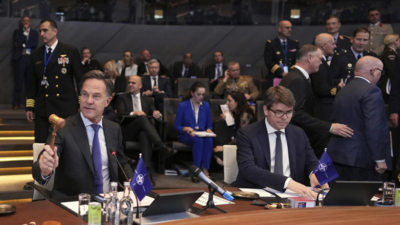Nato is set to approve new military purchases as part of a major defence spending hike

Nato defence ministers are set Thursday to approve purchasing targets for stocking up on weapons and military equipment to better defend Europe, the Arctic and the North Atlantic, as part of a US push to ramp up security spending. The “capability targets” lay out goals for each of the 32 nations to purchase priority equipment like air defence systems, long-range missiles, artillery, ammunition, drones and “strategic enablers” such as air-to-air refueling, heavy air transport and logistics. Each nation’s plan is classified, so details are scarce. “Today we decide on the capability targets. From there, we will assess the gaps we have, not only to be able to defend ourselves today, but also three, five, seven years from now,” Nato secretary-general Mark Rutte said. “All these investments have to be financed,” he told reporters before chairing the meeting at Nato’s Brussels headquarters. US President Donald Trump and his Nato counterparts will meet on June 24-25 to agree to new defence investment goals. US defence secretary Pete Hegseth said that “to be an alliance, you’ve got to be more than flags. You got to be more than conferences. You need to keep combat ready capabilities.” Spurred on by their own security concerns, European allies and Canada have already been ramping up military spending, including arms and ammunition purchases, since Russia launched a full-scale invasion of Ukraine in 2022. At the same time, some allies balk at US demands to invest 5% of their gross domestic product in defence – 3.5% on core military spending and 1.5% on the roads, bridges, airfields and sea ports needed to deploy armies more quickly – when they have already struggled to grow their budgets to 2% of GDP. The new targets are assigned by Nato based on a blueprint agreed upon in 2023 – the military organization’s biggest planning shakeup since the Cold War – to defend its territory from an attack by Russia or another major adversary. Under those plans, Nato would aim to have up to 300,000 troops ready to move to its eastern flank within 30 days, although experts suggest the allies would struggle to muster those kinds of numbers. The member countries are assigned roles in defending Nato territory across three major zones – the high north and Atlantic area, a zone north of the Alps, and another in southern Europe. Nato planners believe that the targets must be met within 5-10 years, given the speed at which Russia is building its armed forces now, and which would accelerate were any peace agreement reached to end its war on Ukraine. Some fear Russia might be ready to strike at a Nato country even sooner, especially if Western sanctions are eased and Europe has not prepared. “Are we going to gather here again and say ‘okay, we failed a bit,’ and then maybe we start learning Russian?” Lithuanian defence minister Dovilė Šakalienė said. Swedish defence minister Pal Jonson also warned that while Russia is bogged down in Ukraine right now, things could quickly change. “We also know after an armistice or a peace agreement, of course, Russia is going to allocate more forces closer to our vicinity. Therefore, it’s extremely important that the alliance use these couple of years now when Russia is still limited by its force posture in and around Ukraine,” Jonson said. If the targets are respected, the member countries will need to spend at least 3% of GDP on defence. Dutch defence minister Ruben Brekelmans said his country calculates in the medium term that “we should spend 3.5% at least on defence, which in the Netherlands means an additional 16 to 19 billion euro ($18-22 billion) addition to our current budget.” The Netherlands is likely to buy more tanks, infantry fighting vehicles and long-range missile systems, including U.S.-made Patriots that can target aircraft, cruise missiles and shorter-range ballistic missiles.








